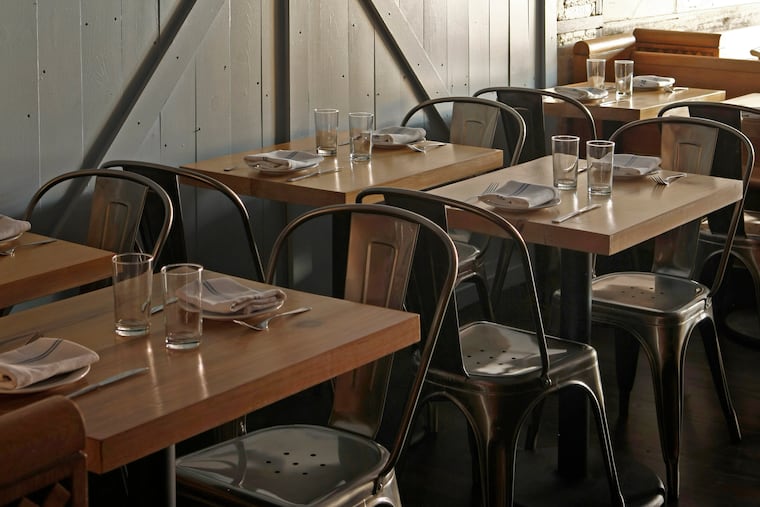Remote work is bad news for the lunch business in Center City
One of the casualties of the pandemic for local restaurants has been lunch business, which is down 22% in Philadelphia.

Customers keep asking if lunch will be back at Barbuzzo, says Valerie Safran, co-owner of several restaurants in Midtown Village.
The requests for lunch service are welcome news to Philly restaurateurs who have been struggling to find their footing after COVID-19 devastated the industry. One of the consequences of the pandemic has been a decline in lunch business, which is down 22% in Philadelphia compared to 2019, according to a recent report from Toast, a restaurant management software company.
“It’s very erratic. Some days are exactly like we used to be. Other days are down,” said Athens Voulgaridis, owner of Olympia Gyro, a Greek restaurant at Reading Terminal Market, which is open until 6 p.m..
The restaurant has fewer regulars than it used to, Voulgaridis said. He’s had to increase prices twice since the start of the pandemic to make a profit. Inflation has been a factor as well.
Another part of the challenge stems from hybrid work, which brings fewer potential customers downtown. Workers have been returning to offices, but only a few days a week, according to a recent report from the Center City District, a business leadership and lobbying organization.
For many white-collar employees — who would often grab lunch in the city’s many eateries — the new work week is Tuesday through Thursday.
“That’s certainly hurting the economic impact of the city because folks are working from home,” said Marc Vetri, owner of Pizzeria Salvy, which opened May 31 at the Comcast Technology Center. Vetri said that he saw a line out the door on Tuesday, Wednesday, and Thursdays when Comcast employees are required to be in the office. On the first Friday it was open, sales were slower. The restaurant is closed Mondays.
How restaurants are adapting
Tucked into tiny Drury Street, McGillin’s Olde Ale House had three or four servers working the lunch shift on weekdays before the pandemic. Now, there are never more than two.
“Because you’re in the office for such a short period of time, you’re not going out for lunch, because you’re only there for three days. That face time is important,” said co-owner Christopher Mullins Jr. In addition to fewer servers, McGillin’s has also stopped offering a free cup of soup to lunch diners.
Oyster House, on the other side of Broad Street, has also made changes as a result of its slower lunch business. The restaurant has a large business clientele, with people spending on average around $50 on lunch. But there just aren’t as many “power lunches” as there used to be, said owner Sam Mink.
He shifted hours to close earlier and also hasn’t opened on Mondays since the start of the pandemic. The shift was originally adopted because of the decrease in business in Center City but also because hiring was difficult.
Now, there’s an upside to the change, said Mink.
“Giving everybody two days off in a row is just great for morale,” he said. “It’s a great incentive to work here.”
Mullins has also found some upside to the dwindling lunch business: Office crowds are showing up around 3 p.m. for drinks, part of a larger trend across the city. He’s also seen an uptick in tourists visiting Philadelphia on day trips from the suburbs, Washington, or New York.
“The tour groups are actually spending more money, which is good. It’s a set menu, so it’s all easier. It’s more predictable,” said Mullins.
Looking ahead
Even amid this downturn in Center City diners, Philly restaurants are on the rise.
Earlier this month, several local chefs and restaurateurs took home prestigious James Beard awards.
“Having three restaurants being named shows the resiliency and diversity and amazing people who are part of the dining scene here in Philadelphia,” Fork’s Ellen Yin, a James Beard winner, said in an interview for Fox 29.
Whether the wins will drive more people to Center City for lunch is yet to be seen.
Mink worries that restaurants will continue to struggle due to fears about the city’s safety, something he’s heard people mention. Many of Oyster House’s customers come from the suburbs.
“We really rely on people to come into the city,” he said.
For now, those coming in for lunch at a.kitchen+bar, are spending more money than they used to, said general manager Harry Jamison.
“Since our lunch guests have shifted from people on lunch break to people who live in the neighborhood, it seems like our lunch guests are looking for a more complete experience on a day off rather than a quick lunch during a work day,” he said.
Starting in mid-July, Safran is going to test a new lunch service at Darling Jack’s Tavern, the newest restaurant she’s opening with her partner, Marcie Turney. The restaurant already offers salads, pizzas, and burgers on the brunch menu, which translates well into lunch, she said.
“If that one seems to do OK, then we would probably open at Barbuzzo for lunch as well,” she said.